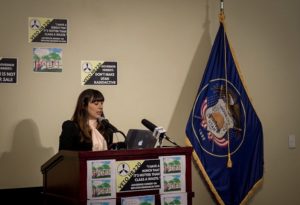
Environmentalists gathered Friday at a press conference hosted by HEAL Utah and the Utah chapter of the Sierra Club to ask Governor Herbert to veto HB220, an amendment many are concerned would lead to the dumping of 700,000 tons of high concentration depleted uranium (DU) and other radioactive material in Tooele County. The amendment has already been approved by both the Utah House and Senate, and Governor Herbert is EnergySolutions’ last hurdle in the HB220 approval process.
While HB220 alone would not allow the importation of DU, Herbert’s signature would be a major step toward EnergySolutions’ end-goal. A new revision of HB220 requires any facility wanting to take in DU to have a performance assessment by and approval from the Department of Energy. In addition, in the event that said facility were to go out of business in the next 1,000 years, the DOE would inherit stewardship over the waste area.
Herbert’s deputy chief of staff Paul Edwards stated, “As with all legislation, we will scrutinize the bill before signing, but the governor believes that his major concerns have been addressed.”
The United States Nuclear Regulatory Commission classifies radioactive waste as A, B, and C, each letter progressively more radioactive than the last. As it stands, Utah only allows the least hazardous radioactive waste, Class A. HB220 sidesteps the current ban by allowing the importation of Class A radioactive materials that with time become more radioactive. DU can be classified as Class A, but instead of becoming safer, it destabilizes, growing even hotter and more hazardous than Class C waste. This radioactivity results from DU’s decay into other elements, and these elements create a massive chemical risk for people and the environment. A quick Google of “radon,” “radium,” “thallium” and “polonium” quickly exposes the massive damage that such elements can cause when it enters the air, water and dust. This is not just a problem for the future, but a problem for today.
BYU geography and chemistry professor Dr. Steve Nelson stated that he does not understand “why anyone with foreknowledge would place an enormous volume of this material in a place that will eventually get out and disperse into the environment.” One concern is that Lake Bonneville’s water levels will someday again rise. Nelson said that because DU is water soluble, this makes its burial in Tooele an irresponsible move.
Nelson explained that there are appropriate ways to dispose of DU, such as New Mexico’s Waste Isolation Pilot Plants’ deep burial of DU in salt deposits. He continued that despite the review process, it is a scientific inevitability that the toxin will eventually be released into the environment. Nelson asks how legislators, if they understand the consequences of DU disposal in Tooele, could “in good conscience vote in favor of it.”
Tooele County chemist Matt McCarty agreed, calling HB220 “bad policy” because it “contradicts good hazard assessment principles” and “ignores the future hazard that will exist.” McCarty also noted that with the passage of HB220 the sole responsibility for determining the acceptance of radioactive waste will be taken from the diverse members of the Board of Hazardous and Radioactive Waste and given solely to the director of that board. He expressed concern that putting such a weighty decision into the hands of a single person will lead to heavy lobbying of that individual.
Director of the Utah chapter of the Sierra Club Ashley Soltysiak noted that this has been an ongoing battle. In 2005, EnergySolutions began accepting massive shipments of DU from the DOE before receiving state approval. After public outcry, Governor Herbert halted train shipments already heading to Utah and requested a study to assess whether EnergySolutions’ site was safe for DU burial. EnergySolutions hired a consulting firm that effectively rubber-stamped the burial of hundreds of thousands of tons of DU in shallow ground (less than three meters) in Tooele County. When the state hired its own consulting firm, several assertions made by EnergySolutions were impugned. Since that time, EnergySolutions has had to undergo an arduous review process. Soltyskiak questions the timing of HB220, which she says is on track to pass before this final review is complete.
Governor Herbert did not attend the conference himself, but HEAL Utah directly delivered over 1,000 postcards to his office following the press conference’s closure . The governor will make his decision within 20 days of the end of the legislative session. The legislative session ends March 14. You can still send a message to Herbert to: https://www.healutah.org/actionalert/
